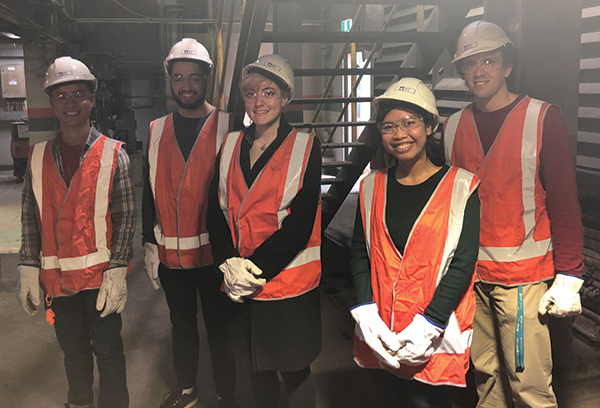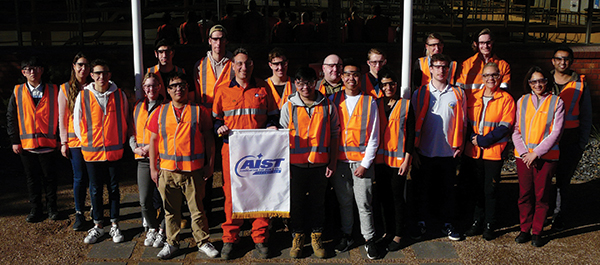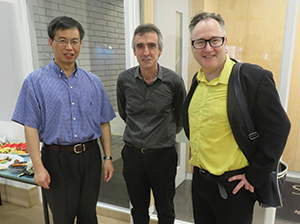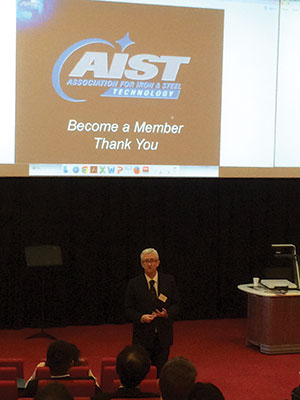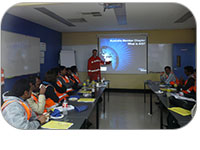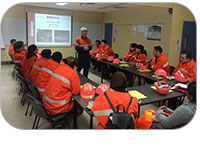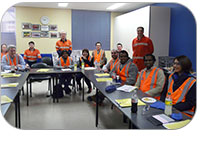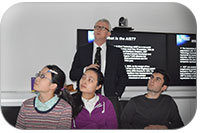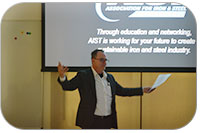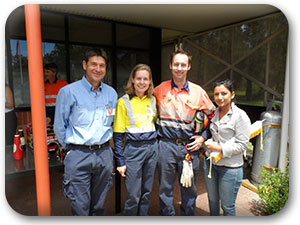Past Australia New Zealand Member Chapter Events
6th Annual Australian and New Zealand Steel Symposium—February 2025
The 6th AIST Annual Australian & New Zealand Steel Symposium took place on 10–11 February 2025 at the Commonwealth Scientific and Industrial Research Organisation (CSIRO) in Clayton, Vic., Australia. Around 80 people attended the symposium, which was offered in person and virtually. The program featured keynote speeches, technical sessions and tours of CSIRO Resources Laboratories and Monash University Materials Characterisation Laboratories.
The sessions covered a range of topics including green steelmaking, direct reduction of iron ore, hydrogen plasma smelting, decarbonization options and advances in steel technology. Specific research on iron ore processing, electric smelting furnaces and the use of renewable carbon in steelmaking were highlighted. A post-symposium plant tour of InfraBuild Steel Mill Laverton was also offered. The event brought together researchers, industry professionals, and students focused on advancements and sustainable practices in the steel industry.
5th Annual Australian and New Zealand Steel Symposium—February 2024
The 5th Annual Australian and New Zealand Steel Symposium was held on 12–13 February 2024 in Melbourne, Australia, at the Swinburne University of Technology. The chapter offered virtual access to the global audience, with 59 attendees in person and 25 people attending virtually. In addition to the 30 technical presentations, there was also a panel discussion on new technologies titled “Can You Go Green Without Going Into the Red?” The panelists were: Sara Hornby, Global Strategic Solutions Inc., Geoffrey Brooks, Swinburne University of Technology; and Ruwan Brell, BlueScope P/L. The panel discussion was moderated Jenny Selway, HILT CRC.
Presentations:
- “The H2 Initiatives — Where Are They?” by Sara Hornby.
- “Economics of Green Hydrogen Production in Australia,” by Akbar Rhamdhani, Swinburne University of Technology.
- “Chemically Patterned Steel,” by Christopher Hutchinson, Monash University.
- “Modeling of Hydrogen DRI Impact Into EAF and BOF,” by Shabnam Sabah, Swinburne University of Technology.
- “Greenfield Zero-Carbon Steel: A Comparison of Available Technologies,” by Mathew Humbert, Swinburne University of Technology.
- “Fundamental Metallurgical Issues Associated With Hydrogen DRI,” by Geoffrey Brooks.
- “ZESTY: A Flash Processing Technology for Decarbonizing Iron and Steel,” by Matt Boot-Handford, Calix.
- “Decoding Government Regulation of Australian Steel Industry Decarbonization,” by David Varcoe, Australian steel industry.
- “Why All the Fuss About Phosphorus in Pilbara Iron Ores?” by Mark Pownceby, CSIRO.
- “A Lower-Temperature Agglomeration Process for Iron Ores,” by Suneeti Purohit, CSIRO.
- “Fundamental Investigation Into the Effect of Various Pre-Melt Reactions on Airflow Resistance During Iron Ore Sintering,” by Tejbir Singh, University of Newcastle.
- “Effect of Anionic Polymer Dispersant on Iron Ore Granule Properties and Sinter Productivity,” by O.A. Aladejebi, University of Newcastle.
- “Low-Grade Fly Ash as a MgO Source for Iron Ore Sintering,” by Mark Pownceby, CSIRO.
- “Quality Considerations When Open-Pour Casting SBQ Grades,” by Shawn Armitage, InfraBuild Steel.
- “Surface Engineering for Lifetime Extension of Steel Mill Rollers,” by Christiane Schulz, LaserBond.
- “Direct Shipping Ore (Iron): Current Deposits, Mine Sources, and Use Cases,” by Charles Tumazos, Strategic Point Partners LLC.
- “Development of H2-Based Steelmaking Route and Electric Smelting Furnace for Low-Grade Australian Iron Ores,” by Quanrong Fan, QRF Consultant.
- “Differences Between Hydrogen and Natural Gas Flames,” by Gopal Pandey, Swinburne University of Technology.
- “Use of Different Lime-Based Products to Promote Agglomeration of Bio-Charcoal for EAF Injection Through Extrusion and Tableting Processes,” by Joyce Aderhold, Lhoist.
- “The ‘Helios Cycle’ Iron Ore Reduction Technology,” by Jill Cooper, Helios.
- “Thermodynamics of Ammonia Ironmaking,” by Tiara Triana, Swinburne University of Technology.
- “Pinpointing Pathways to Wear Resistance,” by Matthew Barnett, Deakin University.
- “On the Role of Interfaces During Metal Additive Manufacturing of Stainless Steels,” by Sophie Primig, University of New South Wales.
- “SENSE 600 – A New Product in a Lower Carbon World,” by Sharmy Francis, InfraBuild Steel.
- “Representative, Real-Time Quality Measurement Technologies for Conveyed Flows to Improve Cokemaking, Ironmaking and Steelmaking,” by Henry Kurth, Scantech.
- “Open-Pour Casting of 0.08% Carbon Billet Grade at Whyalla,” by Israel Murgas, Liberty Steel Whyalla.
- “Major Decarbonization Options for Reheat Furnaces,” by Tharindu Siyambalapitiya, Swinburne University of Technology.
- “Physical Model Studies on the Attenuation of Sound Through Foam in a BOF,” by Jason Heenatimulla, Swinburne University of Technology.
- “Increased Sequence Length on Rail Casting,” by Jari Peltonen, Liberty Steel Whyalla.
- “Impact of Physical and Chemical Properties of Iron Ore Lumps on Reducibility Using Hydrogen,” by Karen Palolite, University of Newcastle.
- “Void Patterning During Hydrogen-Based Iron Oxide Reduction,” by Yuxiang Wu, Max Planck Institute.
4th Annual Australian and New Zealand Steel Symposium—November 2022
The Australia Member Chapter hosted its 4th annual Australian and New Zealand Steel Symposium in person on Monday, 7 November 2022. The chapter also offered virtual access to the global audience.
The symposium brought together academic researchers and engineers to discuss recent advances in iron- and steelmaking technology. Fourteen leading researchers and practitioners offered technical presentations and answered questions for the 78 attendees.
Presentations:
- “Handling the Future Dearth of H2 and DRI-Quality Iron Ore,” by Sara Hornby, Global Strategic Solutions Inc.
- “The Use of Hydrogen in Ferroalloy Making,” by Oleg Ostrovski, University of New South Wales.
- “Physical Chemical Limits to Using Hydrogen in Iron and Steelmaking,” by Geoffrey Brooks, Swinburne University of Technology.
- “Technology Readiness Level and CO2 Reduction Potential of Green Steel Technologies,” by Ahmmad Shahabuddin, Swinburne University of Technology.
- “Green Iron Ore,” by Mark Pownceby, CSIRO Mineral Resources.
- “Hydrogen Reducibility of Iron Ore Sinters,” by Isis Ignacio, Swinburne University of Technology.
- “Simulation of Burden Experience in a Hydrogen Enriched Blast Furnace,” by Nathan Barrett, Centre for Ironmaking Materials Research at University of Newcastle.
- “Temperature Distribution in Iron Ore Sintering Bed Visualized by In-Situ Measurement,” by Kenji Taira, Nippon Steel Corp.
- “Estimation of Zone Temperature Profiles in a BOF,” by Nirmal Madhavan, Swinburne University of Technology.
- “Use of Sound to Measure Slag Foaming in the BOF,” by Jason Heenatimulla, Swinburne University of Technology.
- “Capability Improvement of the Rail Head Hardening Process at the Whyalla Steelworks,” by Israel Murgas and Larisa White, Liberty Primary Steel.
- “Nb Effect on the Austenite Grain Size and Elongation of As-Rolled Microalloyed Rail Steel,” by Israel Murgas and Larisa White, Liberty Primary Steel.
- “Assessment of Metals Extraction Processes on Mars,” by Akbar Rhamdhani, Swinburne University of Technology.
- “Thermal Decomposition of FeO From Silicate Ores,” by Matthew Shaw, Swinburne University of Technology.
3rd Annual Australian and New Zealand Steel Symposium—November 2021
The Australia Member Chapter hosted their 3rd Annual Australian and New Zealand Steel Symposium virtually on Wednesday, 3 November 2021.
The symposium brought together academic researchers and engineers to discuss recent advances in iron- and steelmaking technology. Seventeen leading researchers and practitioners gave presentations on recent advances in the field and answered questions for the audience of 91 attendees.
Welcome and opening remarks were made by chair Andrea Fontana, technical superintendent, InfraBuild Steel. Len Woods, port and technical marketing manager, Taharoa Ironsands Ltd., gave final thoughts at the end of the day.
Presentations:
“Challenges and Opportunities for Steel Scrap Utilization in the UK,” by Zushu Li, University of Warwick.
“Charge Optimization for Residual Control in the EAF,” by Sara Hornby, Global Strategic Solutions.
“How Do Lime Magnetite Pellets (LMPs) Fit Into Lower Carbon Footprint Ironmaking?” by Suneeti Purohit, CSIRO.
“Recent Work of Hydrogen Injection Processes in Ironmaking Blast Furnaces,” by Yansong Shen, University of New South Wales.
“Pelletization and Sintering of New Zealand Titanomagnetite Ironsand,” by Shaira Mendoza, Robinson Research Institute, Victoria University of Wellington.
“Reduction of New Zealand Titanomagnetite Pellets in Hydrogen,” by Ao Zhang, Robinson Research Institute, Victoria University of Wellington.
“Hydrogen Reduction of New Zealand Irons and Using a Laboratory Scale Fluidized Bed Reactor at up to 1,000°C,” by Sigit Prabowo, Robinson Research Institute, Victoria University of Wellington.
“What Is a Good Sinter?” by Isis Ignacio, Swinburne University of Technology.
“Analyses of Pressure Drop in High-Temperature Zone During Iron Ore Sintering,” by Tejbir Singh, University of Newcastle.
“Slag Modification to Improve Spring Steel Quality,” by Israel Murgas, Liberty OneSteel, Whyalla Steelworks.
“Overall Heat Analyses in Oxygen Steelmaking,” by Nirmal Madhaven, Swinburne University of Technology.
“Numerical Modeling of Slag Splashing in Basic Oxygen Steelmaking Furnace,” by Raju Chowdhury, University of Newcastle.
“Acoustic Monitoring of Steelmaking Ladles,” by Rohini Kadam, Swinburne University of Technology.
“An Historical of TEMCO/LBB Production at Bell Bay,” by Samir Ganguly, Hatch.
“Implementation of Thermal Taper and Static Soft Reductions at the Whyalla Combi Caster,” by Jari Peltonen, Liberty OneSteel, Whyalla Steelworks.
“Effect of Silicon on Continuous Cooling Transformation Characteristics in High-Carbon Steel,” by Zeinab Babasafari, University of New South Wales.
“Study of Different Stage of MnS Precipitation in High-Carbon Steel,” by Suk-Chun Moon, University of Wollongong.
Symposium November—2020
The Australia Member Chapter hosted its 2nd Annual Australian and New Zealand Steel Symposium virtually on Wednesday, 18 November 2020. The symposium brought together academic researchers and engineers to discuss recent advances in iron- and steelmaking technology.
Ten leading researchers and practitioners gave presentations on recent advances in the field and answered questions for the 69 attendees.
Presentations:
“Evaluating the Viability of H2-Generated DRI in EAF Melting,” by Sara Hornby, President, Global Strategic Solutions.
“The Status of Research in Hydrogen Generation in Australia,” by Patrick Hartley, Leader, CSIRO Hydrogen Industry Mission, CSIRO Energy.
“Analysis of Residual Elements in InfraBuild’s Scrap Supply,” by Geoff Brooks, Professor, Swinburne University of Technology.
“New Zealand Steel: Challenges in Steelmaking,” by Caitlin O’Connell, Process Engineer, BlueScope New Zealand.
“A Collaborative Approach for Promoting Innovation Across Australian Steel Manufacturing — The Next Ten Years,” by Paul Zulli, Director, ARC Research Hub for Australian Steel Manufacturing and Professorial Fellow, University of Wollongong.
“Green Steel Production: Technology Options, Challenges and Research Needs,” by John Pyke, Australian National University.
“The Hydrogen GREENSTEEL Revolution: Steel, the Enabler,” by Wayne Harris, Head of New Ventures, GFG Alliance.
“Understanding Byproducts to Improve Recyclability: A Case Study,” by Brian Monaghan, Professor, University of Wollongong.
“Opportunities to Enhance (Innovation) the Utilization of Iron and Steel Slags: An Australian Perspective,” by Craig Heidrich, Australasian Slag Association.
“Decreased Sinter Process Variation at BlueScope Steel Using Real-Time Feed Composition,” by Nick Di Giorgio, Senior Development Engineer, BlueScope Steel Port Kembla.
Steelmaking Symposium—May 2019On Thursday, 30 May 2019, the Australian Member Chapter organized the First Australian Steelmaking Symposium at the University of Wollongong (UoW), Wollongong, NSW, Australia. The event was held in conjunction with the 2018 John F. Elliott Lecture, delivered by Ken Coley of McMaster University, Hamilton, Ont., Canada, on the subject of “High-Temperature Kinetics from the Lab to the Steel Plant.”
| |||||||||
Student Plant Tour — May 2018A group of 20 students from the University of New South Wales (UNSW) visited Liberty OneSteel’s Sydney Steel Mill in Sydney, Rooty Hill, Australia, on 28 May 2018. The group was comprised of first- and third-year undergraduate and postgraduate students. They were led by Sophie Primig, senior lecturer and postgraduate coordinator from the School of Materials Science & Engineering.
| |||||||||
Melbourne Metallurgical Forum — February 2018“All things metal” was the focus of the Melbourne Metallurgical Forum, held at Swinburne University of Technology in Melbourne, Australia, on 23 November 2017. The event was designed to showcase the impressive metallurgical research know-how and industry development underway in Australia. The AIST Australian Member Chapter and Materials Australia (peak body for materials science in Australia) sponsored the event. Presentations focused on a variety of topics:
The audience of researchers and industry leaders enjoyed the panel discussion at the end of the day that looked at how we can develop new research opportunities in metallurgical research. At the end of the event, there was wide agreement that this event should become an annual event.
| |||||||||
Tour of OneSteel's Laverton steel works — June 2017On 20 June 2017, the AIST Australia Member Chapter hosted a tour of OneSteel’s Laverton steel works for students and personnel of Swinburne University of Technology, Melbourne. The OneSteel Laverton steel mill is the largest electric steel works in Australia.
| |||||||||
Finding and Tweaking Inclusions in Steel — October 2016Carnegie Mellon University professor Chris Pistorius presented his lecture, titled, “Finding and Tweaking Inclusions in Steel,” at the University of Wollongong in Wollongong, NSW, Australia, and the Swinburne University of Technology in Melbourne, Vic., Australia, in October 2016 as part of the John F. Elliott Lectureship. Both events were well-represented by academia, students and industry with 46 attendees at the University of Wollongong and 54 attending the lecture at the Swinburne University of Technology. | |||||||||
8th High-Temperature Processing Symposium — February 2016The AIST Australia Member Chapter co-sponsored the 8th High-Temperature Processing Symposium, which was held on 1–2 February 2016 at Swinburne University of Technology in Melbourne, Australia. More than 80 attendees gathered from around the world, including: India, China, Korea, Japan, Belgium, Switzerland and Australia. | |||||||||
Tour and Discussion — August 2015On Thursday, 27 August 2015, the AIST Australia Member Chapter hosted a tour of OneSteel’s Laverton Steel Mill in Melbourne, VIC, Australia, for a group of students from Swinburne University. The students were led by Prof. Geoffrey Brooks and Dr. Yvonne Durandet from the Faculty of Engineering, Science and Technology, Swinburne University. Swinburne has had a long relationship with OneSteel, and AIST membership has been growing at the university in recent years as steel-based research expands. Several of the students who attended are part of Prof. Brooks’ high-temperature processing group, including members who are active in steel research projects on slag foaming on BOFs, modeling of dephosphorization in BOFs and development of new sensors for ladle metallurgy. Other students who attended are enrolled in the advanced manufacturing and mechanical engineering courses at the university. This was the first tour of Laverton Steel Mill organized by the Australia Member Chapter. | |||||||||
Student Night – July 2015On 16 July 2015, the Australia Member Chapter, in cooperation with the University of New South Wales (UNSW), organized a Student Night at the university. Twenty-four participants attended the event, including the chapter officers and a guest speaker, David Knights from OneSteel. The event opened with a welcome speech by Paul O’Kane, principal steel manufacturing technology officer, OneSteel, and AIST Australia Member Chapter chair. O’Kane gave a presentation on AIST, which included an overview of AIST, what it aims to achieve, benefits of membership and recent achievements of the Australia Member Chapter. Such recent achievements include ironmaking and sustainability symposia and significant membership growth in 2015. Following O’Kane’s presentation, David Knights, general manager of best practice at OneSteel, shared his career experiences with students and young professionals. Knights gave an overview of his work history and provided his observations, challenges for the steel industry, career opportunities, industry imperatives and platforms for success. He demonstrated how a career in steelmaking can open up global opportunities. After the presentation, dinner was provided for all in attendance. | |||||||||
Plant Tour and Celebration — January 2015The Australia Member Chapter hosted a plant tour of OneSteel’s Sydney Steel Mill on Friday, 30 January 2015. Paul O’Kane, principal steel manufacturing technology officer at OneSteel, and the Australia Member Chapter chair, welcomed all visiting AIST members, non-members and representatives from both industry and the local university. Thirty people participated in the event. After introductions, a safety briefing was held, followed by guided tours of the meltshop and rolling mill departments. The tours provided a great opportunity to see how steel scrap is transformed into finished rolled product. Highlights of the tour included observing OneSteel’s proprietary EAF polymer injection technology in practice and OneSteel’s manufacturing visual key performance indicator (KPI) system. OneSteel’s plant personnel were very accommodating in answering visitors’ questions. Paul O’Kane and Len Woods, metallurgist for Hatch and the Australia Member Chapter secretary-treasurer, gave a presentation about AIST. The presentation included information about AIST’s mission and the benefits of becoming a member. The presentation also highlighted the recent achievements of the Australia Member Chapter, including the ironmaking and sustainability symposia. The Australia Member Chapter has increased its membership by 12% in 2013–2014. The chapter is aiming for significant growth in 2015. | |||||||||
International Sustainability Symposium — October 2013The 2013 International Sustainability Symposium, organized by the AIST Australia Member Chapter and SMaRT@UNSW, was held in Sydney, Australia, on 3–4 October 2013. Delegates from China, India, South Korea, Japan, Sweden, the U.K., the U.S. and Australia attended the symposium, which focused on recycling waste materials. This brought together participants from industry, research organizations and academia. The symposium was inaugurated by Prof. Fred Hilmer, University of New South Wales vice chancellor. Prof. Hilmer addressed and welcomed the attendees and overseas delegates. He stated that the rewards of coming together with colleagues from across the world are compelling, thanks to the power and potential of collaboration. He said that, in the last few decades, the world has consumed resources in great extent. Dealing with waste has been a major challenge for researchers. The symposium provided an opportunity for attendees to interact and exchange ideas on recycling waste. The use of waste rubber tires and plastics to produce green steel was also discussed. Discussions took place throughout the sessions with regard to the approaches taken by industry and research communities. Also at the symposium, Australia Member Chapter chair Paul O’Kane presented the Outstanding Service Award to current secretary-treasurer Narendra Saha-Chaudhury for his outstanding contribution to the Australian Member Chapter over the last 10 years. Finally, O’Kane explained the benefits of becoming an AIST member and suggested that attendees join AIST. | |||||||||
Plant Tour and Technical Presentation — June 2013 On 11 June 2013, the Australia Member Chapter hosted a plant tour to the BlueScope Steel – Port Kembla facility in New South Wales (NSW), Australia. This one-day industrial visit was open to participants from industry and academia with the intent to share knowledge and technological trends conducted at BlueScope Steel. Michael Lopez, Australia Member Chapter chair at the time of the event, welcomed the visitors and introduced those in attendance. The BlueScope Steel safety policy was discussed, followed by an introductory lecture regarding industrial activities at BlueScope Steel – Port Kembla, NSW. After the introduction, the group toured the facility, which included the hot rolled coil steel manufacturing process. The computerized operation, the thickness of coil steel and many other details were discussed with operational facility members. Dr. Rama Mahapatra, principal metallurgist for Castrip LLC (a joint venture company between BlueScope Steel and Nucor Corp.), gave a brief introduction about the technology inventions carried out at BlueScope Steel, discussing many aspects of steelmaking, including their new development of CASTRIP® technology. After the talk by Dr. Mahapatra, lunch was provided. Overall, the visit was valuable and gave insight into coil steelmaking, which has application in the residential, commercial and industrial sectors. | |||||||||
Blast Furnace Seminar — March 2013The Australia Member Chapter hosted a seminar on 18 March 2013 at the University of New South Wales in Sydney, Australia. Fredrick Rorick, president of Rorick Institute, presented, “What I Have Learned From 47 Years at the Blast Furnace.” He began with an enthusiastic introduction on the blast furnace. During his presentation, Rorick said, “It is easier and better to avoid trouble than to try to escape once you are in it.” Rorick went on to explain in detail the “four fundamentals” and “six rules” for success in working with a blast furnace. Finally, Rorick ended his presentation with the following advice: “Reduce variability anywhere and everywhere that you can, even when you cannot immediately calculate a financial benefit.” The presentation provided attendees with a 50-year perspective of working with blast furnaces and experiences in problem-solving. There were 20 attendees at the event. | |||||||||





